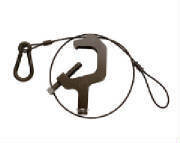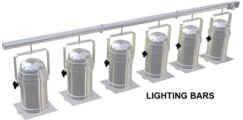You are using an out of date browser. It may not display this or other websites correctly.
You should upgrade or use an alternative browser.
You should upgrade or use an alternative browser.
How many safeties on a PAR-bar?
- Thread starterderekleffew
- Start date
DuckJordan
Touring IATSE Member
1 for each clamp. I've always thought the safety cable was based upon the weight needed for being able to support the weight. 1 C clamp 1 safety...
Morte615
Active Member
Depends on the final weight of the bar. Each light is safetied to the bar, then the bar itself has as many needed to support the weight of the bar fully loaded. The safety cables should have a rating with them, how much shock load the wire rope and connectors can support. I usually would do no less than 3, 1 on each end and 1 in the middle.
Unobtainium.Steel PARs or aluminum?
techieman33
Well-Known Member
2, one near each clamp, and I've never seen anything else in the 8 years I've been doing this.
Well, since safety cables are really designed to catch a light if the cast-iron C-clamp fails, and since there's no C-clamps holding up the individual PARs or the parbar itself, one could argue that you really don't need any. That said, assuming there weren't any safeties already attached coming from the shop, I'd probably be inclined to just use two on the parbar itself.
Les
Well-Known Member
Out of OCD, I'd most likely individually safety each fixture and both ends of the bar to prevent swing, should one end fail. That said, I think you'd only NEED one at each end, as the mounting bolts for the par cans aren't likely to fail if everything is assembled correctly. If you're going to worry about the bolts being undertightened, you need a better crew.
cmckeeman
Active Member
If you're going to worry about the bolts being undertightened, you need a better crew.
The point of a saftey cable is to be a last resort, if you are truly worried that any part might fail you shouldn't send it up.
But at each failure point there should be a saftey which means that each of the pars should be cabled around the bar and around the truss/batton, this way the pipe has a saftey and each par does as well
The point of a saftey cable is to be a last resort, if you are truly worried that any part might fail you shouldn't send it up.
But at each failure point there should be a saftey which means that each of the pars should be cabled around the bar and around the truss/batton, this way the pipe has a saftey and each par does as well
You know -- the lens tube of a Source Four is only held in by a small-diameter, finger-tightened belt. Why not put a safety on that -- it's just as likely to fail if not moreso than a yoke bolt?
What about cable runs -- cables are held up on electrics by tieline. A shoelace knot in tieline is far more likely to fail than a bolt. Why not put safeties on cable runs too?
-Devil's Advocate
cmckeeman
Active Member
Most cable has a tie every few feet, several connections, and a pick, all of those are saftey points which is the redundancy i'm talking about, if you run cable on truss and through span-sett that is another saftey on the cable. which is several redundancies, and sure the lens tube is held in with a small bolt but that bolt is hardly holding any weight where as the c-clamp and or yolk bolt are holding all the weight of the light, having a redundancy around the bulk of the weight makes sense a lens tube not so much. also to strengthen my 6 argument if you have two on the par bar and the bar itself fails in a way that the saftey would catch it the par could slide out unless if it is run through the bar. where as 6 through the yolks would catch any par and the bar itself which is a double redundant safteyYou know -- the lens tube of a Source Four is only held in by a small-diameter, finger-tightened belt. Why not put a safety on that -- it's just as likely to fail if not moreso than a yoke bolt?
What about cable runs -- cables are held up on electrics by tieline. A shoelace knot in tieline is far more likely to fail than a bolt. Why not put safeties on cable runs too?
-Devil's Advocate
You know -- the lens tube of a Source Four is only held in by a small-diameter, finger-tightened belt. Why not put a safety on that -- it's just as likely to fail if not moreso than a yoke bolt?
What about cable runs -- cables are held up on electrics by tieline. A shoelace knot in tieline is far more likely to fail than a bolt. Why not put safeties on cable runs too?
-Devil's Advocate
And what's catching the couple pound chunk of c-clamp falling if that fails?
porkchop
Well-Known Member
There is some risk to anything. I think the point here is at what point do you drawing the line of risks you're willing to accept and what risks you think you need to account for. In this case accounting for a risk means an additional safety cable. That's where details like, how often is this going to be hung/struck, how experienced the people doing the hang are, and who's going to be underneath it while its in the air come into play. It's one of those things where there is no right answer. Just answers that fit a given situation.
MarshallPope
Well-Known Member
And what's catching the couple pound chunk of c-clamp falling if that fails?
Just a thought - would there be anything wrong with gaffing one side of the safety cable to the upper portion of the c-clamp? It may be more trouble than it would be worth, but it seems to me like it could keep c-clamp bits from falling to the stage in case of failure.
Well it depends. Basically I see it as one safety per clamp. If the lights are clamped to a pipe, then they probably had safeties to begin with, so yeah, probably 8 safeties total.
If they are bolted on, there are probably only two clamps, so two safeties.
Now if the bar is on a crank up stand, and the 6 lights are clamped, probably six safeties. But what if they are bolted on? Perhaps no safeties at all? And how big are the bolts?
If they are bolted on, there are probably only two clamps, so two safeties.
Now if the bar is on a crank up stand, and the 6 lights are clamped, probably six safeties. But what if they are bolted on? Perhaps no safeties at all? And how big are the bolts?
What's the rating for gaffers tape?Just a thought - would there be anything wrong with gaffing one side of the safety cable to the upper portion of the c-clamp? ...
IF it's a concern of yours:
L&E Hangtuff™.

I don't know many PAR-bar s that are hung with c-clamp s. See also http://www.controlbooth.com/forums/lighting-electrics/27728-bad-c-clamps.html .
Similar threads
- Replies
- 0
- Views
- 242
- Replies
- 1
- Views
- 648
- Replies
- 0
- Views
- 452
- Replies
- 0
- Views
- 335
Users who are viewing this thread
Total: 1 (members: 0, guests: 1)



